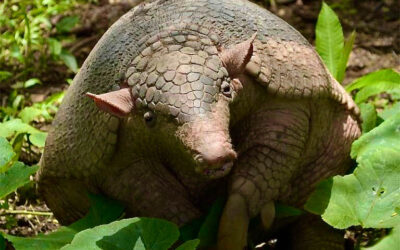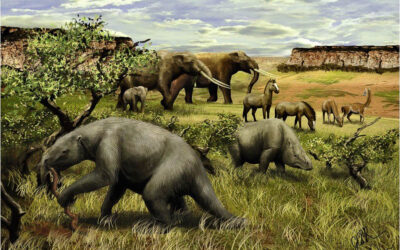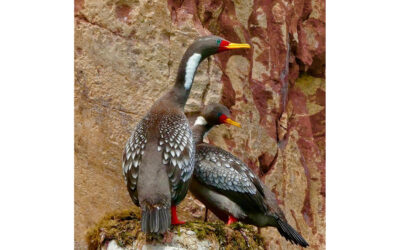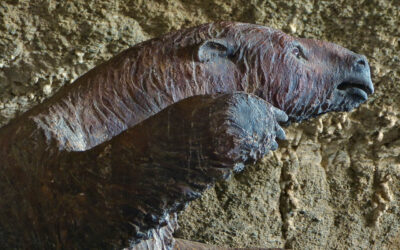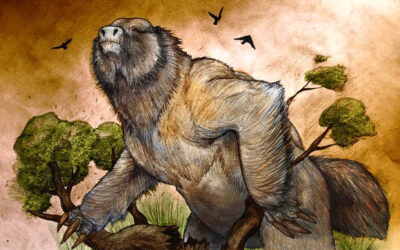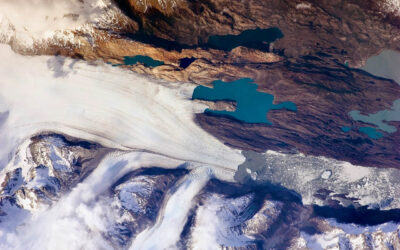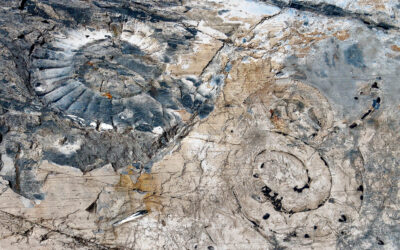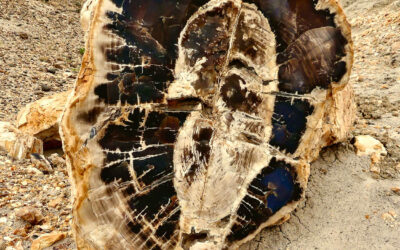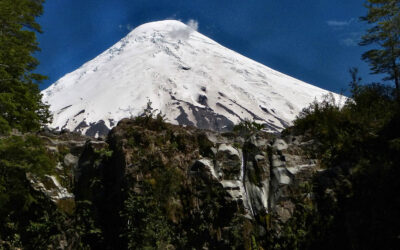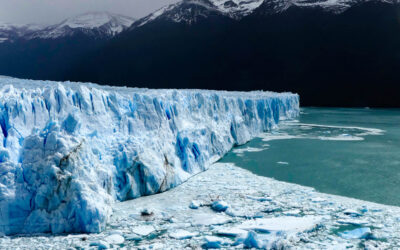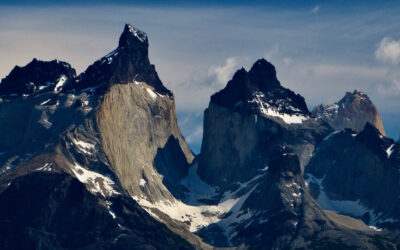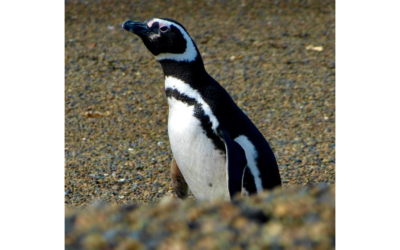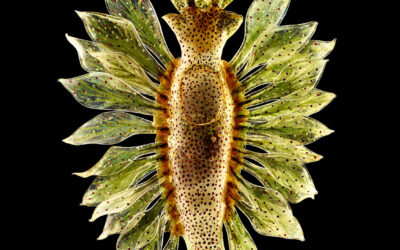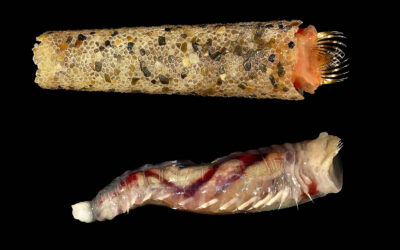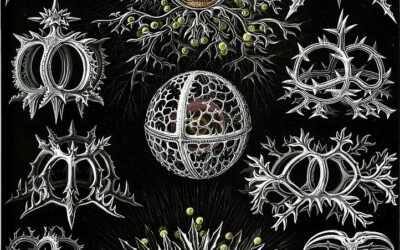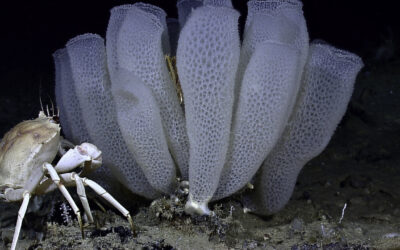To view the full content of each post, please click on the title, featured photo or on “read more” after the post intro.
For a list of all posts without images and preview text, click here. Thank you!
ePostcard #151: The Armadillo Bestiary
There are currently 20 living species of armadillo, and they all share a feature unique among modern mammals—beneath their outer scaly case is an inner shell made up of hundreds of ….
ePostcard #150: Darwin’s Megafauna
Charles Darwin’s discovery of several species of extinct giant mammals, the now celebrated South American megafauna of the last Ice Age, played a key role in the development of his most important contribution to science—
ePostcard #149: A Naturalist’s Bookshelf
I often struggle in trying to explain my abiding fascination with geology. In summarizing his own explorations into Earth’s intricacies, the acclaimed author John McPhee once wrote, “If by some fiat I had to restrict all this writing to one sentence, this is the one I would choose …
ePostcard #148: Darwin’s Sloth
When I view all beings not as special creations, but as the lineal descendants of some few beings which lived long before the first bed of the Cambrian system was deposited, they seem to me to become ennobled.
CHARLES DARWIN, On the Origin of the Species
ePostcard #147: Darwin’s Megafauna Bestiary (Part 1)
Charles Darwin’s made a series of fossil giant mammal discoveries in South America during the Beagle’s voyage that would revolutionize his worldview, shaping his understanding of extinction, and helping persuade him of the reality of evolution. The extinct mammal discoveries that helped Darwin develop his theory included …
ePostcard #146: Reading the Rocks: Cañadon de los Fosiles (Fossil Canyon)
Rock carries its own epithets,Its own refrains. — John McPheePhoto Credits: This 2009 photograph is courtesy of NASA's Earth Observatory archives. You are looking down from space on the Upsala Glacier and its three glacier tributaries (Bertacchi, Cono and Murallón)....
ePostcard#145: Darwin, Geologist!
Most people know Charles Darwin as the founding father of the science of evolution, and as the indefatigable naturalist who gave us our first insights into the fantastic diversity of life on Earth and its origins. Few people realize, however, that Darwin originally joined the H.M.S. Beagle’s 5-year expedition (1831–1836) as an amateur geologist.
ePostcard #144: A Naturalist’s Bookshelf
I subscribe to the stewardship vision best expressed by the great Senegalese environmentalist Baba Dioum—we are moved to conserve what we understand and love. Every so often, in researching the topics for our ePostcard series, I discover a book that deserves special mention for the sheer pleasure of reading good writing interwoven with excellent science …
ePostcard #143: Fire and Ice: Volcán Osorno
When viewed from the air, the snow-covered volcanoes of the Andes rise skyward like sentinels as they guard their mountain stronghold. The first time I saw Volcán Osorno I couldn’t help but think of the passage in Charles Darwin’s journal where he describes standing on the Beagle’s deck and watching …
ePostcard #142: Patagonian Glaciation
The extraordinary ice-sculpted scenery that captures the heart and imagination of everyone who visits Patagonia is the legacy of millions of years of glaciation and erosion. The Patagonian Ice Sheet originated as a large, elongated mountain ice mass that developed over the Andes mountains of southern South America during cold periods. It was divided into two main parts …
ePostcard #141: In Darwin’s Footsteps–Icefield Snapshots from Space
There are only a few places on Earth where you can imagine the ground shifting beneath your feet, where the dynamic natural forces shaping our planet are never at rest. Patagonia is one of those places. Along the Pacific edge of Patagonia, tectonic plates continue to move
ePostcard #140: In Darwin’s Footsteps–A Naturalist’s Journey to Patagonia
For the naturalist, the dramatic coastlines, windswept steppes and spectacular cordilleras of Patagonia need little introduction. From Ferdinand Magellan to Charles Darwin and beyond, explorers’ journals are filled with expressions of wonder at Patagonia’s unforgettable landscapes and unique wildlife.
ePostcard #139: A Naturalist’s Bookshelf
Every so often, in researching the topics for our ePostcard series, I discover a book that deserves special mention for the sheer pleasure of reading good writing interwoven with excellent science. I’ll be interspersing A Naturalist’s Bookshelf whenever thematically appropriate in our ongoing ePostcard series.
ePostcard #138: Windows on the World
"Among the many thousands of things I have never been able to understand, onein particular stands out. That is the question of who was the first person who stood by a pile of sand and said ‘You know, I bet if we took some of this and mixed it with a little potash and...
ePostcard #137: Life in Glass Houses (Part 3)
Photo Credit: Courtesy of Hans Hillewaert and Wikimedia Commons. This amazing photograph of a tube-building marine worm (Lagis koreni) from the Oostendebank (Belgium) in the southern North Sea. The photo shows the sand grain-built tube and 24 mm-long trumpet worm that...
ePostcard #136: Life in Glass Houses (Part 2)
Scientific Illustration Credit: Courtesy of Wikimedia Commons/Public Domain. Ernst Haeckel’s Kunstformen der Natur (1904), plate 71: Drawings by artist and zoologist Ernst Haeckel of the silica exoskeletons of Stephoidea (radiolarians). The individual radiolarian...
ePostcard #135: Life in Glass Houses (Part 1)
Photo Credit: Courtesy of NOAA Okeanos Explorer Program, Gulf of Mexico 2012 Expedition (Wikimedia Commons, Creative Commons Attribution 2.0 Generic License). Golden crab (Chaceon fenneri) and a colony of Venus flower basket glass sponges (Euplectella...

